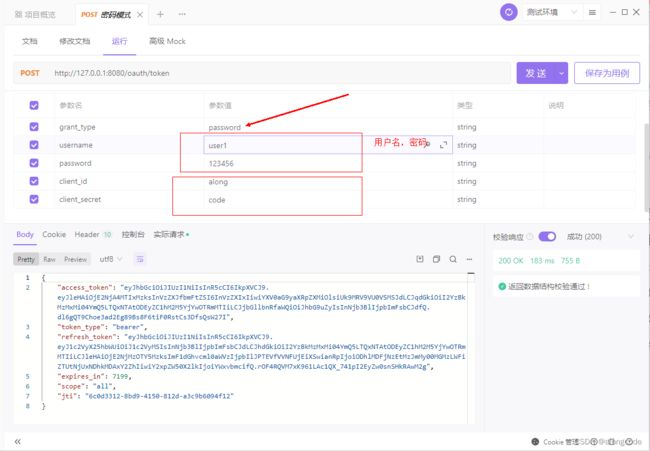springsecurity Oauth2.0 + jwt 极简入门demo
提示:文章写完后,目录可以自动生成,如何生成可参考右边的帮助文档
文章目录
- 前言
- 一、认证服务端搭建demo
-
- 1. AuthorizationServerConfig Oauth2配置类
- 2. JwtTokenConfig JWT配置类
- 3. WebSecurityConfig springsecurity配置类
- 二、四种认证模式
-
- 1. 密码模式 password
- 2. 客户端模式 client_credentials
- 3. 简化模式 Implicit
- 4. 授权码模式 authorization_code
- 三、自定义授权客户端demo
-
- 1. client配置
- 2. WebSecurityConfig springsecurity配置类
- 3. controller
- 4.测试
- 总结
前言
本章节是帮助我们快速上手使用 Spring 提供的 Spring Security OAuth2 搭建一套验证授权及资源访问服务,帮助大家实现企业微服务架构时能够有效的控制多个服务的统一登录、授权及资源保护工作。
server-gitee:https://gitee.com/golden-Kingdragon/springsecurity-oauth2-server-demo.git
client-gitee:https://gitee.com/golden-Kingdragon/springsecurity-oauth2-client-demo.git
提示:以下是本篇文章正文内容,下面案例可供参考
一、认证服务端搭建demo
先引入maven依赖
<dependency>
<groupId>org.springframework.bootgroupId>
<artifactId>spring-boot-starter-securityartifactId>
<version>2.3.12.RELEASEversion>
dependency>
<dependency>
<groupId>org.springframework.security.oauthgroupId>
<artifactId>spring-security-oauth2artifactId>
<version>2.3.4.RELEASEversion>
dependency>
<dependency>
<groupId>org.springframework.securitygroupId>
<artifactId>spring-security-jwtartifactId>
<version>1.0.9.RELEASEversion>
dependency>
1. AuthorizationServerConfig Oauth2配置类
package com.example.demo.config;
import org.springframework.beans.factory.annotation.Autowired;
import org.springframework.context.annotation.Configuration;
import org.springframework.security.authentication.AuthenticationManager;
import org.springframework.security.core.userdetails.UserDetailsService;
import org.springframework.security.crypto.password.PasswordEncoder;
import org.springframework.security.oauth2.config.annotation.configurers.ClientDetailsServiceConfigurer;
import org.springframework.security.oauth2.config.annotation.web.configuration.AuthorizationServerConfigurerAdapter;
import org.springframework.security.oauth2.config.annotation.web.configuration.EnableAuthorizationServer;
import org.springframework.security.oauth2.config.annotation.web.configurers.AuthorizationServerEndpointsConfigurer;
import org.springframework.security.oauth2.config.annotation.web.configurers.AuthorizationServerSecurityConfigurer;
import org.springframework.security.oauth2.provider.code.AuthorizationCodeServices;
import org.springframework.security.oauth2.provider.token.TokenEnhancerChain;
import org.springframework.security.oauth2.provider.token.TokenStore;
import org.springframework.security.oauth2.provider.token.store.JwtAccessTokenConverter;
import java.util.Arrays;
@Configuration
@EnableAuthorizationServer// 这个注解告诉 Spring 这个应用是 OAuth2 的授权服务器
public class AuthorizationServerConfig extends AuthorizationServerConfigurerAdapter {
// @Autowired
// private JwtTokenConfig.CustomJwtTokenEnhancer customJwtTokenEnhancer;
@Autowired
private AuthorizationCodeServices authorizationCodeServices;
//jwt配置
@Autowired
private JwtAccessTokenConverter jwtAccessTokenConverter;
@Autowired
private TokenStore tokenStore;
@Autowired
private AuthenticationManager authenticationManager;
@Autowired
private UserDetailsService userDetailsService;
@Autowired
private PasswordEncoder passwordEncoder;
@Override
public void configure(AuthorizationServerSecurityConfigurer security) throws Exception {
security.allowFormAuthenticationForClients()
.tokenKeyAccess("permitAll()")
.checkTokenAccess("permitAll()");//表单认证(申请令牌)
;
}
@Override
public void configure(ClientDetailsServiceConfigurer clients) throws Exception {
//使用内存存储client凭证,可根据情况改用jdbc存储
clients.inMemory()
.withClient("along")
.secret(passwordEncoder.encode("code"))
.authorizedGrantTypes("authorization_code","client_credentials","password","implicit","refresh_token")
.scopes("all")
.redirectUris("http://127.0.0.1:8081/code")
.accessTokenValiditySeconds(7200);
}
//jwtTokenStore存储
@Override
public void configure(AuthorizationServerEndpointsConfigurer endpoints) throws Exception {
endpoints.authenticationManager(authenticationManager)
.userDetailsService(userDetailsService)
.authorizationCodeServices(authorizationCodeServices);
//将增强的token设置到增强链中
TokenEnhancerChain enhancerChain = new TokenEnhancerChain();
// enhancerChain.setTokenEnhancers(Arrays.asList(customJwtTokenEnhancer, jwtAccessTokenConverter));//添加额外信息
enhancerChain.setTokenEnhancers(Arrays.asList(jwtAccessTokenConverter));
endpoints.tokenStore(tokenStore)
.accessTokenConverter(jwtAccessTokenConverter)
.tokenEnhancer(enhancerChain);
}
}
2. JwtTokenConfig JWT配置类
package com.example.demo.config;
import org.springframework.context.annotation.Bean;
import org.springframework.context.annotation.Configuration;
import org.springframework.security.oauth2.provider.token.TokenStore;
import org.springframework.security.oauth2.provider.token.store.JwtAccessTokenConverter;
import org.springframework.security.oauth2.provider.token.store.JwtTokenStore;
@Configuration
public class JwtTokenConfig {
// @Component("customJwtTokenEnhancer")
// public class CustomJwtTokenEnhancer implements TokenEnhancer {
//实现TokenEhancer(令牌增强器)中的 ehance方法,增加额外的信息
// @Override
// public OAuth2AccessToken enhance(OAuth2AccessToken accessToken, OAuth2Authentication authentication) {
// //token增强逻辑,务必确保保存的信息基本不变
// Map additionalInfo = new HashMap<>();
// //可以获取到代表当前用户的信息
// Object userAuthentication = authentication.getPrincipal();
// additionalInfo.put("Info", "value");
Object userAuthentication = authentication.getPrincipal();
// ((DefaultOAuth2AccessToken) accessToken).setAdditionalInformation(additionalInfo);
// return accessToken;
// }
// }
@Bean
public TokenStore tokenStore(){
return new JwtTokenStore(jwtAccessTokenConverter());
}
@Bean
public JwtAccessTokenConverter jwtAccessTokenConverter(){
JwtAccessTokenConverter jwtAccessTokenConverter = new JwtAccessTokenConverter();
jwtAccessTokenConverter.setSigningKey("alongcode");
return jwtAccessTokenConverter;
}
}
3. WebSecurityConfig springsecurity配置类
package com.example.demo.config;
import org.springframework.context.annotation.Bean;
import org.springframework.context.annotation.Configuration;
import org.springframework.security.authentication.AuthenticationManager;
import org.springframework.security.config.annotation.web.builders.HttpSecurity;
import org.springframework.security.config.annotation.web.configuration.WebSecurityConfigurerAdapter;
import org.springframework.security.core.userdetails.User;
import org.springframework.security.core.userdetails.UserDetailsService;
import org.springframework.security.crypto.bcrypt.BCryptPasswordEncoder;
import org.springframework.security.crypto.password.PasswordEncoder;
import org.springframework.security.oauth2.provider.code.AuthorizationCodeServices;
import org.springframework.security.oauth2.provider.code.InMemoryAuthorizationCodeServices;
import org.springframework.security.provisioning.InMemoryUserDetailsManager;
@Configuration
public class WebSecurityConfig extends WebSecurityConfigurerAdapter {
@Bean
@Override
public AuthenticationManager authenticationManagerBean() throws Exception {
return super.authenticationManagerBean();
}
@Bean
public AuthorizationCodeServices authorizationCodeServices(){
return new InMemoryAuthorizationCodeServices();
}
@Bean
public PasswordEncoder passwordEncoder(){
return new BCryptPasswordEncoder();
}
// 设置添加用户信息,正常应该从数据库中读取
@Bean
public UserDetailsService userDetailsService() {
InMemoryUserDetailsManager userDetailsService = new InMemoryUserDetailsManager();
userDetailsService.createUser(User.withUsername("user1")
.password(passwordEncoder().encode("123456"))
.authorities("ROLE_USER1").build());
userDetailsService.createUser(User.withUsername("user2")
.password(passwordEncoder().encode("123456"))
.authorities("ROLE_USER2").build());
return userDetailsService;
}
@Override
protected void configure(HttpSecurity http) throws Exception {
http.authorizeRequests()
.antMatchers("/oauth/**","/login/**","/logout/**")
.permitAll()
.anyRequest()
.authenticated()
.and()
.formLogin()
.permitAll()
.and()
.csrf()
.disable();
}
}
二、四种认证模式
1. 密码模式 password
2. 客户端模式 client_credentials
3. 简化模式 Implicit
http://127.0.0.1:8080/oauth/authorize?response_type=token&client_id=along&redirect_uri=http://127.0.0.1:8081/code&scope=all
4. 授权码模式 authorization_code
http://127.0.0.1:8080/oauth/authorize?response_type=code&client_id=along&scope=all&redirect_uri=http://127.0.0.1:8081/code
三、自定义授权客户端demo
先引入maven依赖
<dependency>
<groupId>org.springframework.bootgroupId>
<artifactId>spring-boot-starter-oauth2-clientartifactId>
<version>2.6.10version>
dependency>
<dependency>
<groupId>org.springframework.bootgroupId>
<artifactId>spring-boot-starter-webartifactId>
dependency>
1. client配置
server:
port: 8081
spring:
security:
oauth2:
client:
registration:
alongcode:
client-id: along
client-secret: code
authorization-grant-type: authorization_code
redirect-uri: 'http://127.0.0.1:8081/code'
client-name: alongcode
github:
client-id: asfasfasgw312d
client-secret: afasfsafasfasfafasf
provider:
alongcode:
authorization-uri: http://localhost:8080/oauth/authorize
token-uri: http://localhost:8080/oauth/token
2. WebSecurityConfig springsecurity配置类
package com.example.demo.config;
import org.springframework.context.annotation.Configuration;
import org.springframework.security.config.annotation.web.builders.HttpSecurity;
import org.springframework.security.config.annotation.web.configuration.WebSecurityConfigurerAdapter;
@Configuration
public class WebSecurityConfig extends WebSecurityConfigurerAdapter {
@Override
protected void configure(HttpSecurity http) throws Exception {
http
.authorizeRequests(a -> a
.antMatchers("/code/**", "/login", "/error", "/webjars/**").permitAll()
.anyRequest().authenticated()
)
.oauth2Login();
}
}
3. controller
package com.example.demo.controller;
import org.springframework.http.ResponseEntity;
import org.springframework.util.LinkedMultiValueMap;
import org.springframework.util.MultiValueMap;
import org.springframework.web.bind.annotation.GetMapping;
import org.springframework.web.bind.annotation.RestController;
import org.springframework.web.client.RestTemplate;
import java.security.Principal;
@RestController
public class HelloController {
@GetMapping("/hello")
public String hello(Principal principal) {
// return "Hello," + principal.getName();
return "Hello,aa";
}
@GetMapping("/code")
public ResponseEntity<String> code(String code) {
// return "Hello," + principal.getName();
System.out.println(code);
RestTemplate restTemplate = new RestTemplate();
String access_token_url = "http://localhost:8080/oauth/token";
MultiValueMap<String, Object> hashMap = new LinkedMultiValueMap<>();
hashMap.add("grant_type","authorization_code");
hashMap.add("code",code);
hashMap.add("client_id","along");
hashMap.add("client_secret","code");
hashMap.add("redirect_uri","http://127.0.0.1:8081/code");
ResponseEntity<String> responseEntity = restTemplate.postForEntity(access_token_url, hashMap, String.class);
return responseEntity;
}
}
4.测试
启动认证服务器和客户端
浏览器访问:http://localhost:8081/hello

登录

同意授权

得到token

拿到token之后就可以完成自己的逻辑
总结
没有总结。




